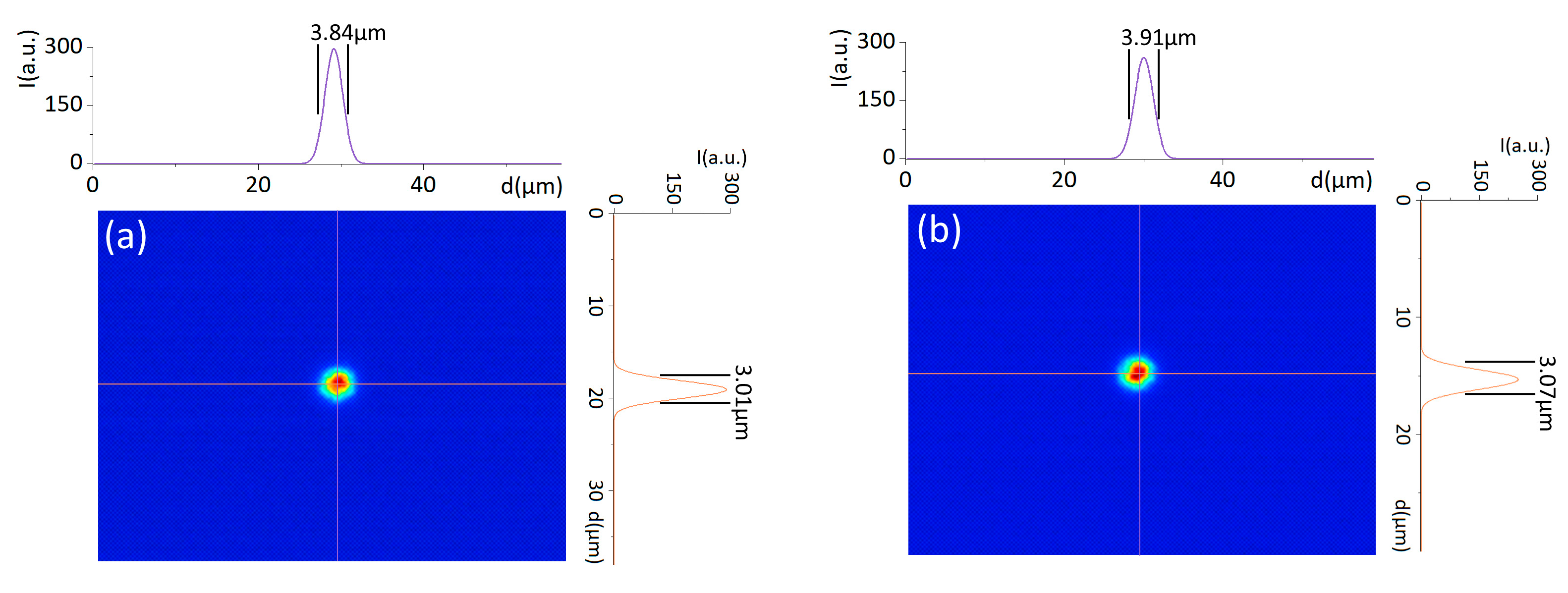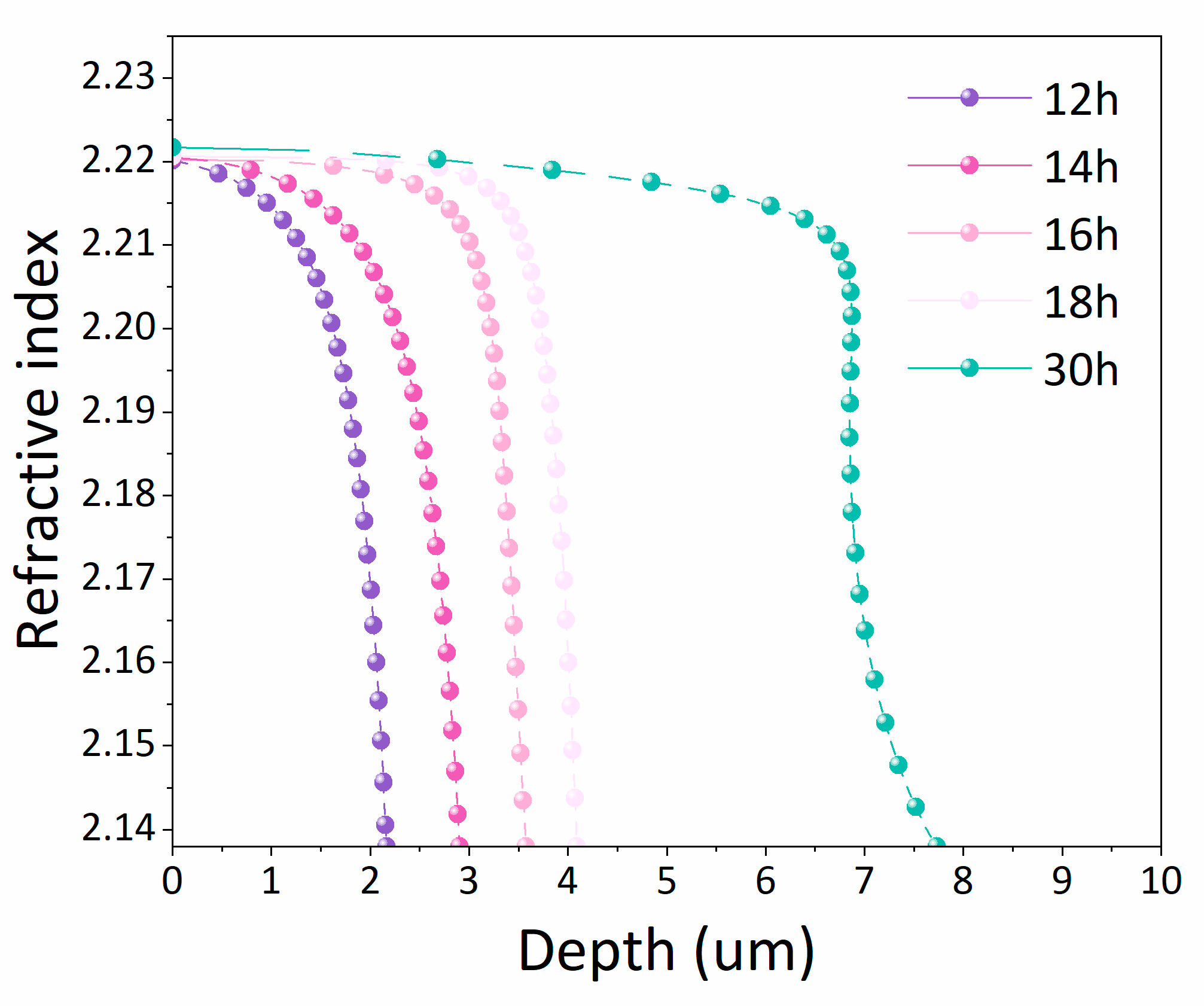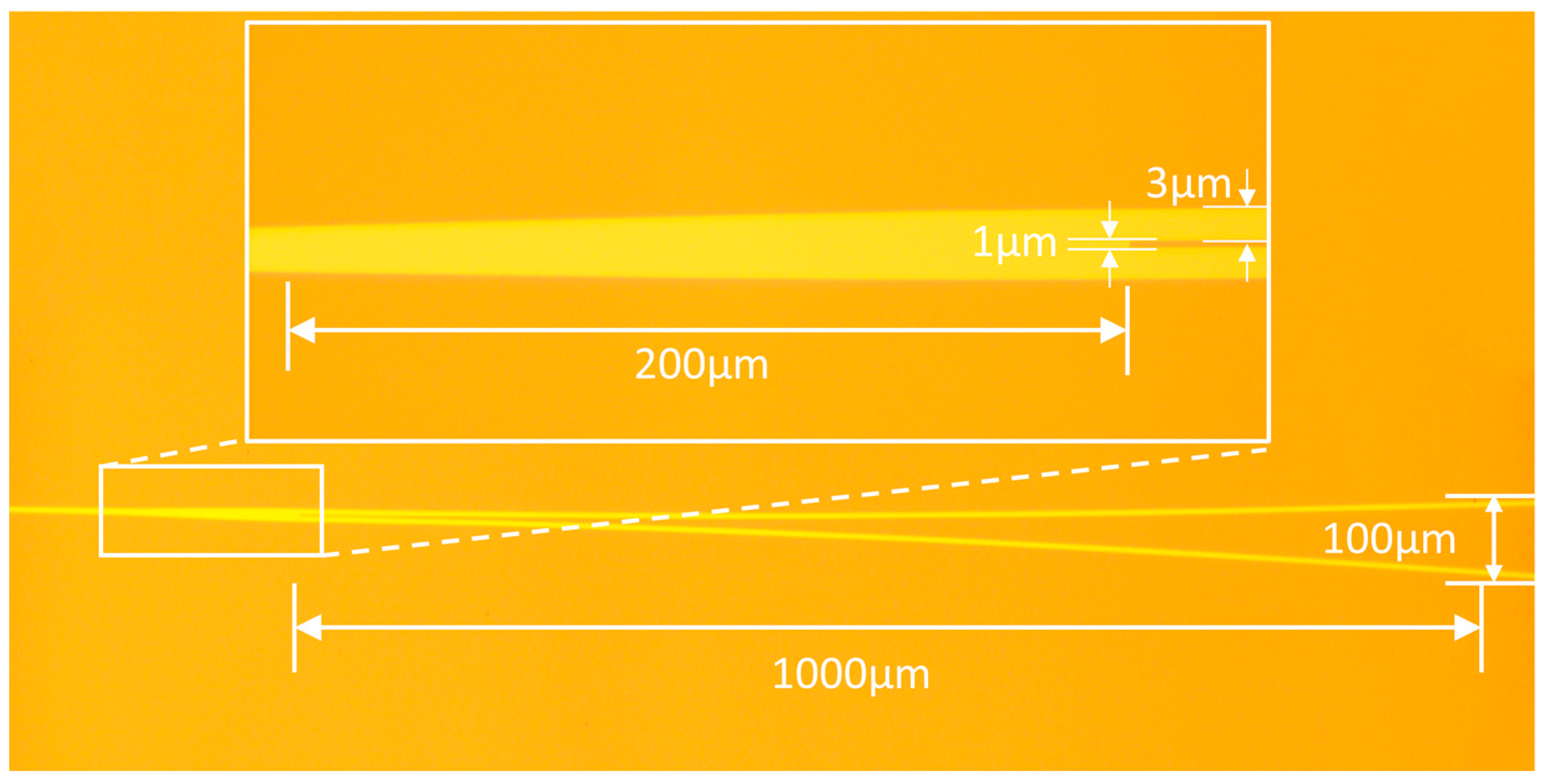X-Cut Lithium Niobate Optical Waveguide with High-Index Contrast and Low Loss Fabricated by Vapor Proton Exchange
Abstract
:1. Introduction
2. Fabrication
3. Measurement and Result
- a.
- The propagation characteristics of the channel waveguide: The pattern image of the channel waveguide with a mask opening of 3 μm, as shown in Figure 7a, was analyzed using FWHM to determine its dimensions in the depth and width directions, which were calculated to be 3.84 ± 0.11 μm and 3.01 ± 0.09 μm, respectively. The propagation loss calculated from the measurements of the five lengths (39 mm, 34 mm, 29 mm, 24 mm, 19 mm) of the channel waveguide was 0.14 ± 0.01 dB/cm, and the polarization extinction ratio was 28.47 dB.
- b.
- Propagation characteristics of the Y-branch waveguide: Figure 7b shows the mode image of the Y-waveguide with a mask opening of 3 μm. The dimensions in the depth and width directions, calculated using FWHM through multiplicative conversion, are determined to be approximately 3.91 ± 0.15 μm and 3.07 ± 0.1 μm, respectively. The beam-splitting loss is 0.028 dB, the beam-splitting ratio is 1:0.9925, and the polarization extinction ratios of the two ports are 28.21 dB and 28.08 dB, respectively.

4. Discussion
5. Conclusions
Author Contributions
Funding
Institutional Review Board Statement
Informed Consent Statement
Data Availability Statement
Conflicts of Interest
References
- Wang, Z.; Wang, C.; Yu, H. Advances in nonlinear photonic devices based on lithium niobate waveguides. J. Phys. D 2023, 56, 083001. [Google Scholar] [CrossRef]
- He, M.; Xu, M.; Ren, Y.; Jian, J.; Ruan, Z.; Xu, Y.; Gao, S.; Sun, S.; Wen, X.; Zhou, L.; et al. High-performance hybrid silicon and lithium niobate Mach–Zehnder modulators for 100 Gbit s−1 and beyond. Nat. Photonics 2019, 13, 359–364. [Google Scholar] [CrossRef]
- Wang, C.; Zhang, M.; Chen, X.; Bertrand, M.; Shams-Ansari, A.; Chandrasekhar, S.; Winzer, P.J.; Lončar, M. Integrated lithium niobate electro-optic modulators operating at CMOS-compatible voltages. Nature 2018, 562, 101–104. [Google Scholar] [CrossRef] [PubMed]
- Guo, Q.; Sekine, R.; Ledezma, L.; Nehra, R.; Dean, D.J.; Roy, A.; Gray, R.M.; Jahani, S.; Marandi, A. Femtojoule femtosecond all-optical switching in lithium niobate nanophotonics. Nat. Photonics 2022, 16, 625–631. [Google Scholar] [CrossRef]
- Liu, H.; Pan, B.; Huang, Y.; He, J.; Zhang, M.; Yu, Z.; Liu, L.; Shi, Y.; Dai, D. Ultra-compact lithium niobate photonic chip for high-capacity and energy-efficient wavelength-division-multiplexing transmitters. Light Sci. Appl. 2023, 4, 1–10. [Google Scholar] [CrossRef]
- Chen, Y.; Liu, G.; Zheng, Y.; Geng, F. Periodically poled Ti-diffused near-stoichiometric MgO: LiNbO3 waveguide nonline-ar-optic wavelength converter. Opt. Express 2009, 17, 4834–4841. [Google Scholar] [CrossRef] [PubMed]
- Yang, X.; Zhang, Z.; Du, W.; Zhang, Q.; Wong, W.H.; Yu, D.; Pun, E.Y.; Zhang, D. Near-stoichiometric Ti:Sc: LiNbO3 strip waveguide for integrated optics. Opt. Mater. 2016, 6, 2637–2643. [Google Scholar] [CrossRef]
- Jackel, J.L.; Rice, C.E.; Veselka, J.J. Proton exchange for high-index waveguides in LiNbO3. Appl. Phys. Lett. 1982, 41, 607–608. [Google Scholar] [CrossRef]
- Bortz, M.L.; Fejer, M.M. Annealed proton-exchanged LiNbO3 waveguides. Opt. Lett. 1991, 16, 1844–1846. [Google Scholar] [CrossRef]
- Korkishko, Y.N.; Fedorov, V.A.; Laurell, F. The SHG-response of different phases in proton exchanged lithium niobate waveguides. IEEE J. Quantum Electron. 2000, 6, 132–142. [Google Scholar] [CrossRef]
- Korkishko, Y.N.; Fedorov, V.A.; Morozova, T.M.; Caccavale, F.; Gonella, F.; Segato, F. Reverse proton exchange for buried waveguides in LiNbO3. J. Opt. Soc. Am. 1998, 15, 1838–1842. [Google Scholar] [CrossRef]
- Langrock, C.; Diamanti, E.; Roussev, R.V.; Yamamoto, Y.; Fejer, M.M.; Takesue, H. Highly efficient single-photon detection at communication wavelengths by use of upconversion in reverse-proton-exchanged periodically poled LiNbO3 waveguides. Opt. Lett. 2005, 30, 1725–1727. [Google Scholar] [CrossRef]
- Chanvillard, L.; Aschiéri, P.; Baldi, P.; Ostrowsky, D.B.; Micheli, M.D.; Huang, L.; Bamford, D.J. Soft proton exchange on periodically poled LiNbO3: A simple waveguide fabrication process for highly efficient nonlinear interactions. Appl. Phys. Lett. 2000, 76, 1089–1091. [Google Scholar] [CrossRef]
- Korkishko, Y.N.; Fedorov, V.A.; Baranov, E.A.; Proyaeva, M.V.; Morozova, T.V.; Caccavale, F.; Segato, F.; Sada, C.; Kostritskii, S.M. Characterization of alpha-phase soft proton-exchanged LiNbO3 optical waveguides. J. Opt. Soc. Am. 2001, 18, 1186–1191. [Google Scholar] [CrossRef] [PubMed]
- Rams, J.; Cabrera, J.M. Nonlinear optical efficient LiNbO3 waveguides proton exchanged in benzoic acid vapor: Effect of the vapor pressure. J. Appl. Phys. 1999, 85, 1322–1328. [Google Scholar] [CrossRef]
- Ramponi, R.; Osellame, R.; Marangoni, M.; Russo, V. Vapor-phase proton exchange for high quality lithium tantalate waveguides. In Proceedings of the Conference Digest, 2000 Conference on Lasers and Electro-Optics Europe (Cat. No.00TH8505), Nice, France, 10–15 September 2000. [Google Scholar]
- Rambu, A.P.; Apetrei, A.M.; Doutre, F.; Tronche, H.; De Micheli, M.; Tascu, S. Analysis of High-Index Contrast Lithium Niobate Waveguides Fabricated by High Vacuum Proton Exchange. J. Light. Technol. 2018, 36, 2675–2684. [Google Scholar] [CrossRef]
- Rambu, A.P.; Apetrei, A.M.; Tascu, S. Role of the high vacuum in the precise control of index contrasts and index profiles of LiNbO3 waveguides fabricated by high vacuum proton exchange. Opt. Laser Technol. 2019, 118, 109–114. [Google Scholar] [CrossRef]
- Nahm, H.; Park, C. Microscopic structure of hydrogen impurity in LiNbO3. Appl. Phys. Lett. 2001, 78, 3812–3814. [Google Scholar] [CrossRef]
- Casey, H.C.; Chen, C.; Zavada, J.M.; Novak, S.W. Analysis of hydrogen diffusion from proton-exchanged layers in LiNbO3. Appl. Phys. Lett. 1993, 63, 718–720. [Google Scholar] [CrossRef]
- Rambu, A.P.; Apetrei, A.M.; Doutre, F.; Tronche, H.; Tiron, V.; De Micheli, M.; Tascu, S. Lithium niobate waveguides with high-index contrast and preserved nonlinearity fabricated by a high vacuum vapor-phase proton exchange. Photonics Res. 2020, 8, 8–16. [Google Scholar] [CrossRef]
- Rams, J.; Cabrera, J.M. Preparation of proton-exchange LiNbO3 waveguides in benzoic acid vapor. J. Opt. Soc. Am. B 1999, 16, 401–406. [Google Scholar] [CrossRef]
- Radojevic, A.M.; Osgood, R.M.; Roy, N.A.; Bakhru, H. Prepatterned optical circuits in thin ion-sliced single-crystal films of LiNbO3. IEEE Photon. 2002, 14, 322–324. [Google Scholar] [CrossRef]
- Niu, Y.; Yang, L.; Guo, D.; Chen, Y.; Li, X.; Zhao, G.; Hu, X. Efficient 671 nm red light generation in annealed proton-exchanged periodically poled LiNbO3 waveguides. Chin. Opt. Lett. 2020, 18, 111902. [Google Scholar] [CrossRef]
- Mu, X.; Yue, X.; Chen, J.; Wang, J.; Shao, Z. Planar waveguide refractive index distribution functions determined precisely from mode indices. Appl. Opt. 1994, 33, 3227–3230. [Google Scholar] [CrossRef] [PubMed]
- Rice, C.E. The structure and properties of Li1-xHxNbO3. J Solid State Chem. 1986, 64, 188–199. [Google Scholar] [CrossRef]
- Korkishko, Y.N.; Fedorov, V.A. Structural phase diagram of Hx/Li1-xNbO3 waveguides: The correlation between optical and structural properties. IEEE J. Sel. Top. Quantum Electron. 1996, 2, 187–196. [Google Scholar] [CrossRef]
- Fedorov, V.A.; Korkishko, Y.N. Crystal structure and optical properties of proton-exchanged lithium niobate waveguides. In Proceedings of the SPIE’s 1994 International Symposium on Optics, Imaging, and Instrumentation, San Diego, CA, USA, 24–29 July 1994. [Google Scholar]
- Ito, K.; Kawamoto, K. Dependence of Lattice Constant Deviation and Refractive Index on Proton Concentration in Proton-Exchanged Optical Waveguides on a Single Crystal of LiNbO3. Jpn. J. Appl. Phys. 1992, 31, 3882–3887. [Google Scholar]
- Paz-Pujalt, G.R.; Tuschel, D.D.; Braunstein, G.; Blanton, T.N.; Lee, S.; Salter, L.M. Characterization of proton exchange lithium niobate waveguides. J. Appl. Phys. 1994, 76, 3981–3987. [Google Scholar] [CrossRef]
- Peng, Y.; Dai, J.; Li, C. Vapour proton exchange. J. Atmos. Environ. Opt. 2005, 18, 6–9. [Google Scholar]






| Fabrication Technique | Fabrication Condition | Index Contrast | Waveguide Width | Nonlinear Effect | Polarization Property | α 3 | Fabrication Scale |
|---|---|---|---|---|---|---|---|
| TD [6,7] | ≥1000 °C, ATM 1 | 0.006~0.015 | ~10 μm | high performance | non | 0.4~0.7 dB/cm | wafer |
| APE [23,24] | 150~250 °C, ATM 1 | 0.01~0.03 | ~6 μm | requiring annealing for restoration | self-polarization | 0.1~0.2 dB/cm | wafer |
| VPE [21] | ≥300 °C, HV 2 | ≥0.08 | ≤3 μm | high performance | self-polarization | 3.5 dB/cm | 10 × 15 mm |
| Reaction Vessel | Temperature | Index Contrast | Repeatability | Substrate | α 1 |
|---|---|---|---|---|---|
| Ampoule [19] | 350 °C | 0.10 | High | Z-cut LN | 3.5 dB/cm |
| quartz flask [31] | 245 °C | 0.11 | Low | Z-cut LN | / |
| improved quartz crucible in this paper | 300 °C | 0.08 | High | X-cut LN | 0.14 dB/cm |
Disclaimer/Publisher’s Note: The statements, opinions and data contained in all publications are solely those of the individual author(s) and contributor(s) and not of MDPI and/or the editor(s). MDPI and/or the editor(s) disclaim responsibility for any injury to people or property resulting from any ideas, methods, instructions or products referred to in the content. |
© 2023 by the authors. Licensee MDPI, Basel, Switzerland. This article is an open access article distributed under the terms and conditions of the Creative Commons Attribution (CC BY) license (https://creativecommons.org/licenses/by/4.0/).
Share and Cite
Rong, S.; Wen, X.; Ding, N.; Liao, J.; Hua, P. X-Cut Lithium Niobate Optical Waveguide with High-Index Contrast and Low Loss Fabricated by Vapor Proton Exchange. Photonics 2023, 10, 1390. https://doi.org/10.3390/photonics10121390
Rong S, Wen X, Ding N, Liao J, Hua P. X-Cut Lithium Niobate Optical Waveguide with High-Index Contrast and Low Loss Fabricated by Vapor Proton Exchange. Photonics. 2023; 10(12):1390. https://doi.org/10.3390/photonics10121390
Chicago/Turabian StyleRong, Shicheng, Xujie Wen, Ning Ding, Jia Liao, and Pingrang Hua. 2023. "X-Cut Lithium Niobate Optical Waveguide with High-Index Contrast and Low Loss Fabricated by Vapor Proton Exchange" Photonics 10, no. 12: 1390. https://doi.org/10.3390/photonics10121390
APA StyleRong, S., Wen, X., Ding, N., Liao, J., & Hua, P. (2023). X-Cut Lithium Niobate Optical Waveguide with High-Index Contrast and Low Loss Fabricated by Vapor Proton Exchange. Photonics, 10(12), 1390. https://doi.org/10.3390/photonics10121390




